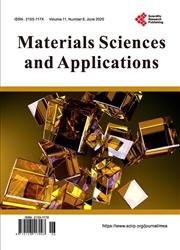Impact of Cr Substitution on Structural, Magnetic, Electric and Impedance Study of Mn-Ni-Zn Ferrites
引用次数: 2
Abstract
A series of Cr3+-substituted Mn-Ni–Zn ferrites; Mn0.5Ni0.1Zn0.4Fe2-xCrxO4 (x = 0.0 - 0.4 in a step of 0.1) were prepared by traditional solid-state reaction route. The structural, magnetic, dielectric properties and impedance spectroscopy of these compositions were studied. Phase identification and lattice constant (a0) determination were carried out by X-ray diffraction (XRD). The XRD patterns established the fabrication of a single-phase spinel structure. The FESEM micrographs exposed that the average grain size () increased slightly with chromium (Cr) substitution and then decreased for a higher concentration of chromium in the composition. The real part of initial permeability () diminished owing to the enhanced porosity of the compositions with the increase of Cr3+ content in the composition. The highest relative quality factor (RQF) was attained for the samples with x = 0.1. The magnetic hysteresis was investigated to know the effect of Cr3+ substitution in the composition of the magnetic properties. The decrease of saturation magnetization (Ms) with an enhancement in Cr3+ might be triggered by switching of Fe3+ ions from octahedral to tetrahedral site. The samples with x = 0.1 exhibited the highest anisotropy constant (K). Curie temperatures of the investigated samples were significantly modified to lower temperatures with the Cr3+ content. The frequency characteristics of dielectric properties and impedance spectroscopy had been investigated. The highest dielectric constant (e') and resistivity were observed for x = 0.1 and x = 0.2 samples. The complex impedance spectra analysis reveals in-depth information about the conduction mechanism, microstructure, and orientation of the grains in the samples.Cr取代对Mn-Ni-Zn铁氧体结构、磁性、电学和阻抗研究的影响
一系列Cr3+取代的Mn-Ni-Zn铁氧体;采用传统的固相反应路线制备了Mn0.5Ni0.1Zn0.4Fe2-xCrxO4(x=0.0-0.4,步进0.1)。研究了这些组合物的结构、磁性、介电性能和阻抗谱。通过X射线衍射(XRD)进行了相鉴定和晶格常数(a0)测定。XRD图谱确定了单相尖晶石结构的制备。FESEM显微照片显示,平均晶粒尺寸()随着铬(Cr)的取代而略有增加,然后随着组合物中铬浓度的增加而减小。随着组合物中Cr3+含量的增加,由于组合物的孔隙率增加,初始渗透率的实际部分()减小。对于x=0.1的样品,获得了最高的相对质量因子(RQF)。研究了磁滞现象,以了解Cr3+取代对磁性能组成的影响。随着Cr3+的增强,饱和磁化强度(Ms)的降低可能是由Fe3+离子从八面体位置转换为四面体位置引起的。x=0.1的样品表现出最高的各向异性常数(K)。随着Cr3+含量的增加,研究样品的居里温度显著降低。研究了介电特性的频率特性和阻抗谱。x=0.1和x=0.2样品的介电常数(e’)和电阻率最高。复阻抗谱分析揭示了样品中晶粒的传导机制、微观结构和取向的深入信息。
本文章由计算机程序翻译,如有差异,请以英文原文为准。
求助全文
约1分钟内获得全文
求助全文

 求助内容:
求助内容: 应助结果提醒方式:
应助结果提醒方式:


